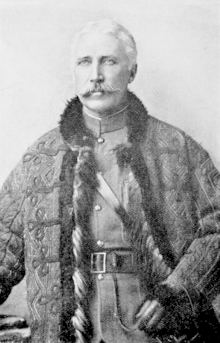Bindon Blood
| General Sir Bindon Blood | |
|---|---|
 | |
| Born |
7 November 1842 Scottish Borders |
| Died |
16 May 1940 (aged 97) London |
| Allegiance |
|
| Years of service | 1860–1940 |
| Rank | General |
| Commands held | Northern Army, India |
| Battles/wars |
Siege of Malakand Chitral Expedition Second Anglo-Afghan War battle of Tel-el-Kebir First World War |
| Awards |
Knight Grand Cross of the Order of the Bath Knight Grand Cross of the Royal Victorian Order |
General Sir Bindon Blood, GCB, GCVO (7 November 1842 – 16 May 1940) was a British Army commander who served in Egypt, Afghanistan, India and Southern Africa.
Military career
Born near Jedburgh, Scotland, Blood was related to Colonel Thomas Blood who attempted to steal the Crown Jewels in 1671. Blood attended the Royal School, Banagher, Queen's College, Galway, and the Addiscombe Military College. He was commissioned in 1860 in the Royal Engineers as a temporary lieutenant in charge of signalling and pontoon bridge construction in India, and for brief periods in Zululand and South Africa. Promoted to captain in 1873, he served with British forces in the North-West Frontier (Jowaki). In 1879 he was sent back to Africa for the Anglo-Zulu War. He went on to fight in the Second Anglo-Afghan War and the battle of Tel-el-Kebir. By 1882 he was a brevet lieutenant-colonel.
The following year, 1883, Blood married Charlotte E. Colvin, second daughter of Sir Auckland Colvin, a distinguished Indian administrator from a well-connected family. Then he returned to India and took command of the Bengal Sappers and Miners in 1885. After seven years he reached the rank of brigadier-general, serving in the garrison at Rawalpindi, and then in the relief force known as the Chitral Expedition. He then commanded the Malakand Field Force and the Buner Field Force, relieving the garrison during the siege of Malakand. At the end of this command he was promoted to major-general.
Lord Kitchener succeeded as chief of command during the Second Boer War in late 1900, and requested Blood for service in South Africa, where he arrived in early March 1901. He spent six months fighting in the Eastern Transvaal and received the local rank of Lieutenant-General on the Staff in April 1901.[1] In late September 1901 he returned to India to take up the position of Commander-in-Chief Punjab Command, where he arrived the following month.[2] He kept the local rank of Lieutenant-General.[3]
In November 1907 he retired to London, where he continued to lead a very active life. He was made colonel-commandant of the Royal Engineers in 1914 and worked to recruit soldiers for the First World War. He was aged 94 when he was made Chief Royal Engineer (CRE) in 1936.[4] He died in 1940, survived by his one daughter.
Dedication
Winston Churchill, who served under Blood on the North-West Frontier in 1897, dedicated his first non-fiction book, The Story of the Malakand Field Force (1898), to "Major-General Sir Bindon Blood, K.C.B., under whose command the operations therein recorded were carried out; by whose generalship they were brought to a successful conclusion; and to whose kindness the author is indebted for the most valuable and fascinating experience of his life".[5]
References
- ↑ The London Gazette: no. 27310. p. 3035. 3 May 1901.
- ↑ Army Commands Archived 5 July 2015 at the Wayback Machine.
- ↑ The London Gazette: no. 27387. p. 8840. 13 December 1901.
- ↑ "Sir Bindon Blood Dead at Age of 98". The Montreal Gazette. 17 May 1940. Retrieved 8 November 2013.
- ↑ Churchill, Winston L. Spencer (1898). The Story of the Malakand Field Force: an episode of frontier war. London, UK: Longmans, Green.
Sources
- Profile, ThePeerage.com; retrieved 2 June 2007.
External links
- Royal Engineers Museum Blood's Pontoon (1870–89)
- Royal Engineers Museum The Corps between the wars (1919–39)- General Blood's appointment to Chief Royal Engineer
| Honorary titles | ||
|---|---|---|
| Preceded by Philip Gordon Grant as Director of Fortifications and Works |
Chief Royal Engineer 1936–1940 |
Succeeded by Sir Ronald Charles |